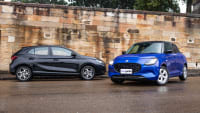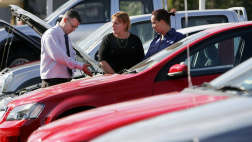Off roading is a great experience, but can be hazardous for both you and your vehicle. These tips will help you avoid problems when out in the rough stuff.
GENERAL
- Always check the ground ahead if you're unsure. This includes water crossings, mud and sand sections.
- Constantly watch the ground. Look for alternative routes.
- Avoid hand/finger damage by keeping your thumbs to the outside of the steering wheel rim.
- Low tyre pressures will avoid getting stuck. As a rough guide, for general trails, about 25-28psi; for sand, about 15psi; and for mud, about 15psi. Remember that low tyre pressures equals low vehicle speed.
- For difficult areas, keep in a low gear and revs about 2000-3000rpm. Don't change gear during the manoeuvre.
- Cross small bumps straight on; bigger bumps at a slight angle; and ditches at an angle.
- Straddle ruts, especially for uphill sections. Be prepared to use rocks/logs to fill in holes and aid traction.
MUD
You've seen mudwrestling on TV and you've probably seen the 1978 cult movie The Mud Monster (aka The World Beyond) - driving in mud is all this and more. Get it wrong and you'll be seriously dirty.
Tips:
- The proper tyres are vital. Open tread pattern with aggressive lugs.
- Approach the mud in 4WD Low second or third gear.
- Speed (momentum) and power (keep engine on torque band) are vital.
- Maintain a steady pace.
- Keep to the high points (if possible)
- Move the steering wheel quickly side to side to make the tyres bite and improve traction.
- If you get stuck, rock the vehicle backwards or forwards by alternating between first and reverse.
WATER CROSSINGS
Trust me - you're likely to get wet.
- Get out of the vehicle and check the route. Prepare to get wet.
- Most 4WD vehicles will handle up to water depths of up to 300mm. Some are rated up to 700mm. But that depends on the floor of the water and the current flow. A snorkel for deeper water may be needed.
- Spray electrical components with a dewatering solution (WD40) before entering the water.
- Loosen the fan belt (unless it has a clutch)
- In water depths over 300mm, remove the fan belt and fit a cover over the radiator. This prevents the fan bending into the radiator and helps create a bow wave.
- Keep your speed low but enough to create a bow wave. Choose 4WD Low second.
- Do not change gears.
- Keep the engine running, even if you stop. If the engine does stop, DO NOT restart it. Winch or snatch out.
- Be aware that wet brakes will have poor stopping ability. After the crossing, slowly drive with brakes applied gently.
- Check the engine. Check the oil dipsticks for water contamination - white colour in the oil.
HILLS
Up or down, patience is the key.
- Choose 4WD Low second or third gear for uphill; 4WD Low first or second downhill.
- Allow plenty of room with the vehicle in front or behind. Watch the vehicle in front and follow the best path.
- Don't touch the clutch and use the brake sparingly.
- Do not turn the vehicle sideways.
- If the vehicle starts to slide sideways, very slight acceleration and steering into the slide will normally straighten your descent.
- If you stall going uphill, don't touch the clutch or accelerator. The best stall technique is to drive the vehicle - in low gear, no clutch, no accelerator and no brake - with the starter motor.
- Many new 4WDs have ``downhill assist'' systems that automatically keep the vehicle at a set speed.
- The last resort to getting up a hill is winching.







.jpg)
.jpg)



.jpg)
.jpg)

.jpg)



.jpg)
.jpg)



